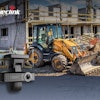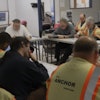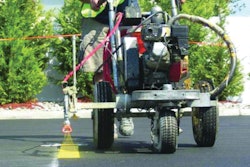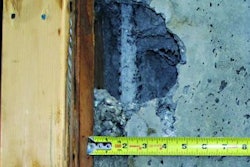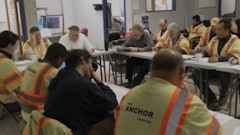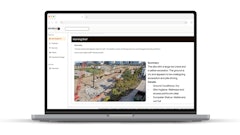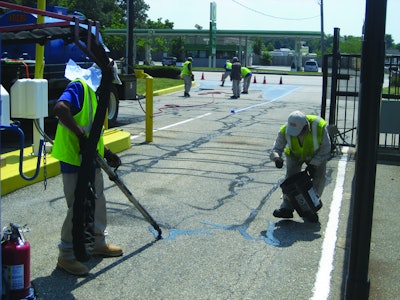
Job costing, the single most important task in an estimating systems process, is something that is often neglected by many start-up, small, and mid-sized pavement maintenance companies. Failing to job cost effectively or failing to execute job costing at all would be similar to a pilot attempting to fly a plane through thick cloud cover without being instrument rated.
In this business contractors constantly complain about the competition: “That guy low-balls everything,” or “I just stopped bidding against that company,” or “These guys are (insert derogatory term here),” and, my personal favorite, “I don’t know how that guy makes any money!”
Well, here’s a news flash: He most likely is not making any money. Those same contractors usually have a life of less than two years. In fact, the paving and pavement maintenance industry probably has a higher turnover rate of contractors in business than most businesses have for turnover of employees.
It is the sad fact of the matter, however, that with the low barrier to entry in our trade there’s always someone who thinks a pavement maintenance business is a “get rich quick” opportunity. Usually by the two-year mark, assuming the contractor is paying taxes, his certified public accountant (CPA) sits him down and lets him know the hard truth: “You’re broke.” His employees, who probably do less work than he does, probably have made more money than the owner himself. At this point, the owner attempts to sell everything the company owns -- which is usually very little -- with an advertisement headlined “Money Maker,” “Get Rich Quick,” or “Turn Key.” The question I always ask, just for pure entertainment, is, “If you can make so much money with this equipment, why are you selling it?” I seldom get an answer.
History
Like many contractors I started my business sealcoating driveways on weekends through high school and college, and I was fortunate enough to have a mentor guiding me along the way. So when I started Brahney Industries and its Driveway Guardian subsidiary I already realized the importance of job costing. I understood that there was a target I needed to hit. When I made that transition to a “full time” entrepreneur in 2001 I had a vision for my company and, more importantly, I realized that most of my competition was not making any real money with the prices they were charging.
Because I didn’t want to compete in a market where I couldn’t make any money I did what most contractors would consider career suicide: I moved to a different part of the state into a new market and immediately priced my services at 20% - 30% higher than the competition. I did this because I knew what it cost me to complete a job and I knew that pricing at that level was the only way I could make a profit that I considered to be worth the risk of being in business. (It took time but after about two years people stopped telling me that I was 20% higher than the competition.)
In January 2002 I decided to shift the company’s focus to serve large national accounts, expand our services, and broaden our geographical reach from New Jersey to the entire Tri-state area from April through October, shifting the business to South Florida from November through March. In 2002 we were awarded two national accounts that had properties in both markets, and we were on our way. In January 2003, I formed Brahney Pavement Solutions as a single-source provider of complete pavement maintenance and management systems to large real estate investment trusts and national accounts, and that year we were awarded four additional national accounts.
Since then we have added an asphalt recycling division and introduced our (877) FIX-ASPHALT vanity phone number into our marketing plan to develop brand recognition. Today Brahney Pavement Solutions employs 20 People and owns over 30 different pieces of equipment to provide full-service pavement maintenance including sealcoating, crack repair, pavement marking, asphalt resurfacing, infrared repair, concrete work, and pavement management.
Our growth and reliance on job costing didn’t prevent new companies coming into the marketplace -- we still face start-up contractors determined to be the low-price provider. But like clockwork a year or so after they start I can call their telephone number and hear, “Bing bong, the telephone number you dialed, (111) 555-1212 has been disconnected.” That contractor probably visited his CPA 30 days earlier and realized the sad truth that he did not know the true costs of running his business.
How we job cost effectively
Job costing is a very detailed process, and the more detail you include the more accurate your costs will be. I suggest every contractor learn as much about it as possible. Here’s an overview of what works for us.
Overhead: This is the first cost you have to understand and get a handle on. Overhead includes everything it costs you run your business every day: trucks, equipment, rent, wages, insurance – everything.
Equipment is a make-or-break component of any overhead structure. To begin determining your equipment overhead you need to determine your cost for each piece of equipment (either on an hourly, daily, or monthly basis). This cost must include any lease payment, fuel, insurance, office support, operator, maintenance etc. The more elements you include and the more detailed your cost breakdown the more accurate you cost for each piece of equipment will be. If you can break your equipment costs down for each individual piece of equipment – as opposed to overall equipment costs -- that is very helpful, so it would be best to enlist the help of your CPA (though there is software out there that will help you determine these raw costs on your own).
Once you have determined your equipment overhead you need determine all the other costs of running your business. This list will vary from contractor to contractor but can include office or yard rent, advertising, phone and internet, office salaries and benefits, sales costs, entertainment for clients – anything that it costs you to run your business. Adding these general costs to your equipment costs gives you your basic overhead cost to run the business for the year.
After you arrive at your total for your equipment costs and your other more general costs you need to estimate the number of days or hours your business operates (on average) per season. Your total overhead for the year, divided by the amount of hours or days you work per year, will give you your overhead burden or percentage. If your overhead is $100,000 and your company works 150 days a year your overhead is $100,000 divided by 150 or $666.66 per day. That means that just to cover your overhead you need to generate an average of $666.66 per working day. That’s where you start building your bid. I prefer to overestimate on my overhead cost and underestimate the days worked per year. I find by doing this I always come out ahead and cover any overruns, such as a new equipment purchase, and I manage to compensate for extra rainy days.
Once you have determined your average overhead you need to estimate your labor and production values. Make sure to keep in mind when determining a worker’s hourly rate that a $12 per hour worker’s true cost is usually around $17.00 hour or more (once benefits, taxes, and my personal favorite, workers’ comp insurance is included).
Next you need to develop average production rates as well for each employee. This is achieved by taking a week and visiting your job sites. You will then record average times for each task, so you begin to figure out it takes X amount of minutes for 2 person cleaning crew with a 18 HP blower and steel wire broom to clean 10,000 sq ft for a “clean” parking lot etc etc. You can use this formula for each task you perform from cleaning to breaking our concrete with a skid steer and hydraulic ram.
Crew rates: Next we develop “crew rates” for each of our crews. A crew is comprised of the people, equipment, materials, and overhead. The crew rate is how much production we can get out of each crew. For example: I know that one of my sealcoating crews can complete an average of 10,000 sq. ft. per hour of sealer application by hand, 16,000 sq. ft. per hour by squeegee machine, and 50,000 sq. ft. per hour by spray bar truck. These are averages we use in “crew templates.” Determining production is as important as having accurate financials at your finger tips when determining these numbers.
Material Cost: Add together all components related to the cost of your materials including the material itself, taxes, and delivery. Divide that total by your coverage rate (in the case of sealcoating).
Mark-up: This is my favorite part. The mark-up is the reason we wake up every morning to deal with the one “favorite” employee who is determined to test your limits every day. The mark-up is your profit, the reason you have become an entrepreneur, and this is where a balancing act comes into play.
By using different forecasting models, you have to determine how much money you want to make this year. For example: Let’s say you want your company to make $125,000 profit for seven months of work. By looking at the jobs you are estimating and your raw costs, you have to determine price-wise in your market where you are pricing your jobs, your average closing ratio, the average size job you can complete more efficiently than your competition, and how that correlates to your closing ratio.
Seven months a year equates to 28 weeks, and if you determine you can work five days out of every seven you will be working 140 days a season. If you want to earn $125,000 profit you have to be able to make a profit of $892.86 a day after all of your costs ($125,000 divided by 140 days). This is on top of the overhead costs and the material costs you have already determined. This is where the balancing act and historical information comes into play. To me this is the fun part. You have to consider that these variables can change from day to day and that is why I call it an “average.”
Let’s assume you are a sealcoating entrepreneur who has one pick-up truck with a 550-gal. trailer unit and five employees. You have one employee who helps you perform estimate take offs and sales, three employees who actually work on the sealcoating team with one supervisor, and you as owner act as the production/quality control foreman while also helping your estimator when he/she gets busy.
You are very confident in your team’s production levels; this is where the average comes in. One day you sealcoat a $20,000 job, which relates to a profit of $9,000. In effect you have just credited your profit account with a profit of $8,107.14. However, what you have to remember is that your overhead burden, which you have costed out for 140 days, a year is still
“running” the remaining 4 days a week. GMAC doesn’t care that your truck is down for two days, they still want their money at the beginning of the month for your truck payment. The flip side is, if your truck goes down for two days, that $8,107.14 helps mitigate the loss to a degree. This is why it is all an “average.”
By using an Excel spread sheet or an accounting software set up with budgets for each income and expense account, you can keep a running total and review it weekly to benchmark yourself.
Profit vs. salary: Don’t confuse profit with your salary. Profit is the money that is retained after all of your bills, including your own salary, is paid for the year. Some contractor’s mistake profit for salary and if you do, depending on the size of your operation, you might find yourself in a financial bind when you get ready to kick-start the next season. If you made a $125,000 profit, but your season start-up costs are $75,000, then in effect you are “lending” the business $75,000 to get started for the year.
So don’t forget to budget your “start-up costs” to kick-start operations for the season (if you are in a seasonal market). These include your advertising, initial purchase of raw materials, equipment maintenance, operating capital, initial fuel purchases, etc.
Technology can help
In today’s age of technology it is more important than ever to have a computer-based estimating “system” to help you accurately job cost. Doing things “the old fashioned way” with paper and pencil leaves too much of a margin for error -- a margin that no one can afford to find out the hard way doesn’t work.
When I started my business I formatted a simple Excel spreadsheet to job cost and it has proved effective until 2007 when our business grew to a point where we outgrew the system. In 2007 we switched to Bid2Win by Niche Software and since then have watched our job costing be refined to a level I never conceived possible. Here’s an example of how job costing has helped us:
In November I had bid on a paving project with a separate pay item for “removal and replacement of 32,000 sq. ft. of alligator-cracked asphalt.” We determined that our raw costs on the project were approximately $225,000, and I put a mark-up into the project of $52,000 which brought my total bid up to $277,000.00.
We lost the bid to a competitor who had nowhere near the amount of resources we had to complete the project but who had won the project for $197,000. I happened to run into him at a vendor’s office about 10 days after he completed the project. I remarked to him about how low his bid had been, and I told him I figured the raw costs to be around $225,000. I told him we derived our raw costs from a new “paving specific” software program we were using for estimating. He said without hesitation, “I don’t need no software program or computer to tell me how much money I’m makin’.”
Maybe. But I know that he won the bid for significantly less than the raw costs should have been, not including any profit. So either the client didn’t get what he paid for, or the contractor lost money on the job – a distinct possibility.
I would strongly recommend that before you start bidding work this season that you sit down with your CPA to look at your “historical” costs and production rates to help develop an accurate job costing system. There are a number of very inexpensive (less than $400) accounting software programs on the market or you can use something as simple as a formatted Excel spreadsheet. (Programming formulas into Excel is easier than most people think.)
I would never recommend job costing using pencil and paper; it’s too hard to track and update and leaves too much margin for error. In today’s marketplace you have to be computer literate to succeed.
Bidding work without knowing your “true costs” is like sailing a ship without a compass. You never know where you will end up, maybe you will find your port, and maybe you won’t. In today’s economy, you can’t “afford” to miss your target!
“Push-button” service
To better service its customers Brahney Pavement Solutions has developed what it terms “push button” service, available through its website. Available to clients under contract who have multiple properties, the service is used extensively by customers needing immediate help for pothole repair, car stop or bollard repair, striping touch up, any trip or liability hazard, and a variety of other must-fix jobs.
Fees for the service vary but a base fee increases the farther the property is from the contractor’s Hillsborough, NJ, headquarters. Property managers who want to use the service can enter a work order online and the contractor responds as soon as the order is placed.
Idle equipment can make you money
Equipment is great when you need it, but when it sits, you might as well just stick vinyl dollar signs on it because it’s costing you money. If you have equipment that you work only one or two days a week – yet you determine that you really need it to complete your projects -- consider leasing it to other companies, creating a secondary revenue stream. For example, many contractors are on the lookout for companies with reliable dump trucks (with or without drivers) to deliver asphalt. A spare “experienced” paving crew is also in demand. When working on smaller projects for our national accounts, it’s sometimes not feasible to mobilize to another state for a small project. So we sometimes “lease” a paving crew and dump trucks from a screened local contractor, paying them per day while we supply the asphalt. These are areas that could contribute revenue to lessen your overhead burden.

